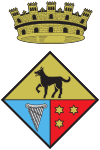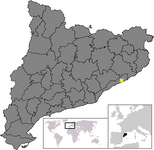Calella
| Calella municipality | ||
|---|---|---|
 Calella Beach
|
||
| coat of arms | Map of Spain | |

|
|
|
| Basic data | ||
| Autonomous Community : | Catalonia | |
| Province : | Barcelona | |
| Comarca : | Maresme | |
| Coordinates | 41 ° 37 ′ N , 2 ° 40 ′ E | |
| Height : | 5 msnm | |
| Area : | 7.9 km² | |
| Residents : | 19,069 (Jan. 1, 2019) | |
| Population density : | 2,413.8 inhabitants / km² | |
| Municipality number ( INE ): | 08035 | |
| administration | ||
| Mayor : | Montserrat Candini i Puig (CiU) | |
| Website : | www.calella.org | |
| Location of the municipality | ||

|
||
Calella [ kəˈleʎə ] is a Spanish city on the Catalan Costa del Maresme and is 56 kilometers from Barcelona . To better differentiate it from Calella de Palafrugell , the unofficial name Calella de la Costa is used . Given the large number of German tourists, the place is also known as Calella dels Alemanys (in Catalan) or Calella de los Alemanes (in Spanish).
In Calella, around 19,069 people live on 7.9 km² (as of January 1, 2019). The main source of income is - as in most of the cities on the Costa del Maresme - tourism , in summer during the main holiday season there are three tourists per inhabitant.
Cityscape
The cityscape of Calella is characterized by many hotel complexes and other guest accommodations. In the meantime, however, the poorer hotels are being dismantled or extensively renovated - there are almost no new hotel buildings. Instead, more and more apartment buildings are being built, which mostly serve as weekend apartments for wealthy Barcelonians.
Even if the city is characterized by hotels seen from the beach, Calella still has an old town. The majority of the tourists are young people who are attracted by the large party mile. The Casc Antic still has the charm of a typical Catalan small town, even if the city administration uses places like the Plaça de la Constitució, where the town hall is located, or the Plaça de l'Església at the church of Santa Maria i Sant Nicolau for easier cleaning Has remodeled slabs and stones. Above the old town, which is largely within walking distance through narrow alleys and bazaar streets, National Road II, which runs from the French - Spanish border towards Barcelona, separates the old town from the new town.
The large sandy beach and the beach promenade are separated by the tracks of the Rodalies , a kind of suburban train that runs along the Costa Brava and the Costa del Maresme to Barcelona. By modernizing the tracks and railways as part of the 1992 Summer Olympics , the former noise pollution has largely been reduced.
Landscape and surroundings
Calella has a roughly 3.5 kilometers long, coarse-grained sandy beach. Below the lighthouse behind the end of the main beach - around the rocks - there is a small bay, which is designated as a nudist beach. Rocca Grossa beach, like Roca Pins beach, is south of the lighthouse and is one of the managed family beaches. These are closed bathing bays that can be reached via stairs from the N II. There are two other bathing bays, but they are more difficult to reach. In the hinterland of Calella, the wooded mountain range of the Serra de Montnegre extends , a nature reserve that offers numerous hiking trails.
tourism
Alongside Lloret de Mar , Calella is the second most popular holiday destination east of Barcelona with young people. There are numerous nightclubs along the Rambla de Capasbre , and the entire city center is dominated by hotel guests.
traffic
The city is accessible by public transport through the Calella train station on the line from Barcelona to Maçanet-Massanes . Mainly regional trains of the Rodalies Barcelona run here , as well as a night train to Madrid once a week. Some bus routes take care of the fine distribution.
Attractions
The sights of Calella include the town hall, the neoclassical church of Sant Maria i Sant Nicolau, the lighthouse built in 1859, the shopping street with its Mediterranean flair, and the ruins of two signal towers of a line of optical telegraphs from the 19th century, the first of which is called Les Torretes Tower (built in 1848) was used for military communications, the second, taller tower (built in 1857) for commercial communications.
Sports
Since 2009, the Ironman Barcelona (until 2013 as Challenge Barcelona-Maresme ) has been held here in October, a long-distance triathlon (3.86 km swimming, 180.2 km cycling and 42.195 km running).
Town twinning
- Ille-sur-Têt in the Pyrénées-Orientales department , ( France ) since December 13, 1987
Sons and daughters (selection)
- Josep Maria Terricabras (* 1946), Spanish philosopher and politician
Individual evidence
- ↑ Cifras oficiales de población resultantes de la revisión del Padrón municipal a 1 de enero . Population statistics from the Instituto Nacional de Estadística (population update).
literature
- Calella . German edition. Barcelona 2001 ISBN 84-875-8736-4




